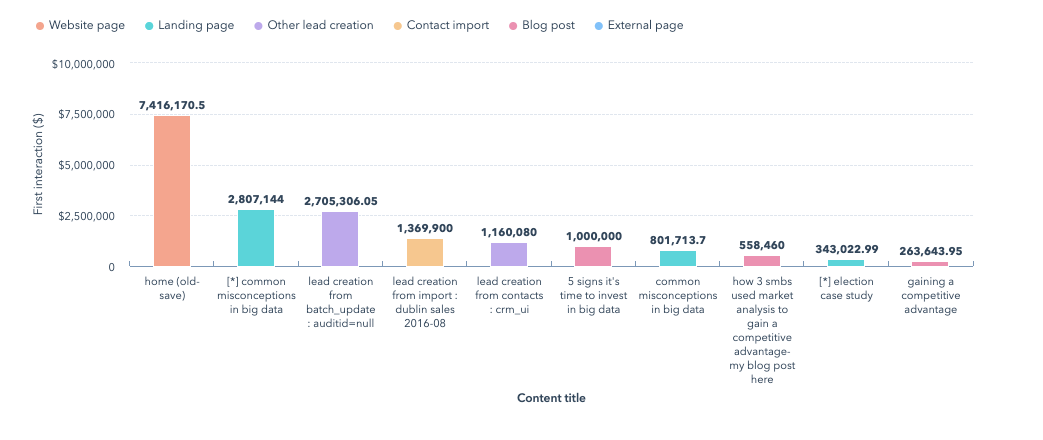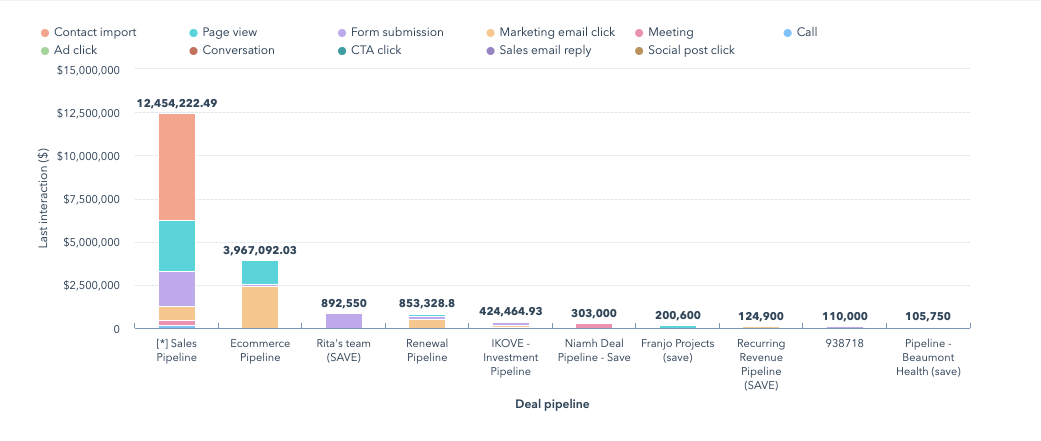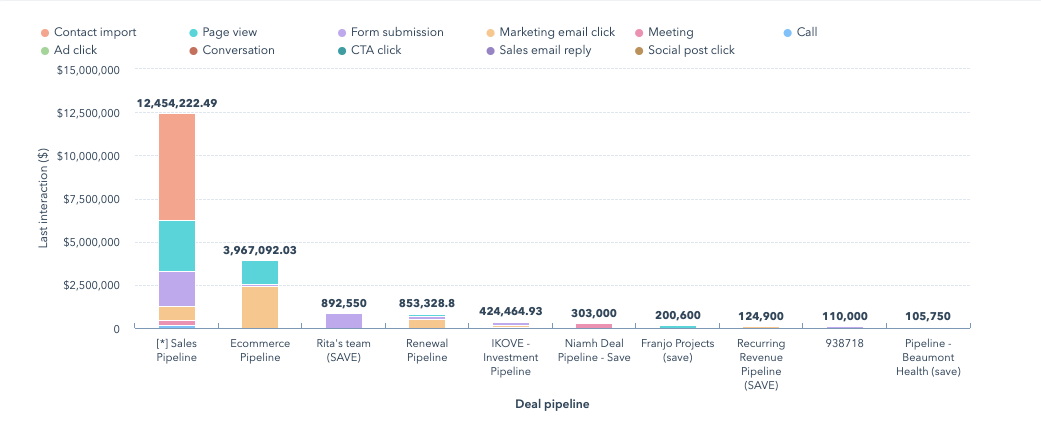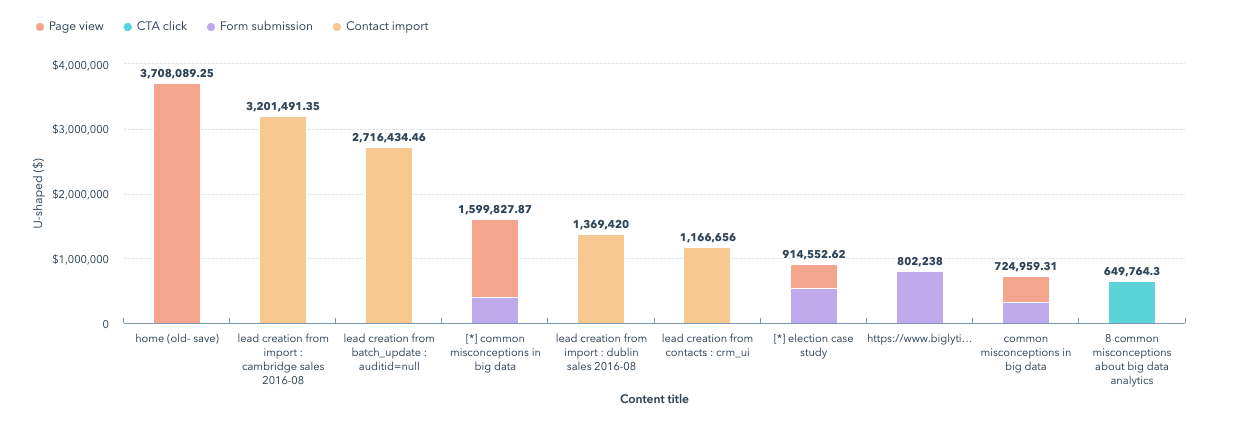Choosing the right marketing attribution model for your business in HubSpot involves understanding your marketing goals, customer journey, and the specific characteristics of your sales cycle. Attribution collects the marketing touchpoints where your customer interacts with your website, landing pages, and blog posts, gathering data on the full path to lead creation and onto closed won revenue.
As marketers, it’s our responsibility to analyse data to help understand where best to deploy marketing activities and budget to obtain the best results. Revenue attribution reports are crucial to the evaluation of your channels. Here's a comprehensive guide to help you select the most suitable attribution model:
1. Understand Your Marketing Goals
Your choice of an attribution model should align with your marketing objectives. If your goal is to increase brand awareness, first-touch attribution might be most relevant, as it gives full credit to a customer's first interaction with your brand.
Conversely, if you're focused on conversions or sales, a model that attributes more credit to the final touchpoints, like last-touch or W-shaped attribution, might be more appropriate.
2. Analyse the Customer Journey
Consider the complexity and length of your customer journey. For businesses with a longer sales cycle involving multiple touchpoints, multi-touch attribution models provide a more accurate picture of what drives conversions.
Linear attribution evenly credits each touchpoint, making it suitable for businesses where each interaction is considered equally important. In contrast, time-decay attribution might be better for shorter cycles, as it gives more credit to interactions closer to the conversion.
3. Evaluate Your Sales Cycle
The length and complexity of your sales cycle can significantly influence the choice of attribution model. For longer sales cycles, consider models that account for early-stage interactions, such as linear or U-shaped attribution.
Last-touch or time-decay models might be more relevant for shorter cycles, emphasising the final interactions leading to a conversion.
4. Consider Your Marketing Channels
Different attribution models may be better suited to businesses depending on their primary marketing channels. A multi-touch model that can attribute credit to both types of interactions would be beneficial if you use a mix of online and offline channels.
For predominantly online channels, models that can accurately track digital touchpoints, such as U-shaped or W-shaped attribution, might be more appropriate.
5. Experiment and Compare Models
HubSpot allows you to compare the performance of different attribution models side-by-side. Experimenting with various models can provide insights into how different touchpoints contribute to conversions.
This comparative analysis can help you identify which model best aligns with your business goals and customer journey.
6. Leverage HubSpot's Tools
HubSpot offers several attribution models, including first touch, last touch, linear, U-shaped, W-shaped, and custom models. Utilise HubSpot's built-in tools and analytics to track the performance of your marketing campaigns across these models.
This will help you understand which touchpoints are most effective at driving conversions and where to allocate your marketing resources for the best ROI.
7. Customise Your Model
Consider creating a custom attribution model if the standard models don't fully meet your needs. This involves assigning weights to different touchpoints based on their importance in your sales cycle.
Custom models can be handy for businesses with unique customer journeys or those that use a wide range of marketing channels.
In summary
Selecting the right attribution model in HubSpot is crucial for accurately measuring the effectiveness of your marketing efforts. By aligning the model with your marketing goals, understanding your customer journey, and leveraging HubSpot's analytics tools, you can make informed decisions that drive your business forward.
Remember, there's no one-size-fits-all solution; the best approach is to experiment with different models and continuously refine your strategy based on the insights you gather.
What are some common attribution models used in HubSpot?
In HubSpot, several common attribution models are used to analyse the impact of different marketing efforts on generating leads, deals, and revenue. These models help understand how various interactions contribute to conversions throughout the customer journey. Here are some of the common attribution models used in HubSpot:

1. First-Touch Attribution

2. Last-Touch Attribution
Opposite to the first-touch model, last-touch attribution assigns all the credit to a contact's last interaction before converting. This model helps in understanding which efforts are most effective at closing deals.

3. Linear Attribution
Linear attribution distributes credit equally across all touchpoints that contributed to the conversion. This model is beneficial for recognising the overall journey and how each interaction leads to a conversion.
4. Time-Decay Attribution
Time-decay attribution gives more credit to interactions closer to the conversion time. It's useful for short-term campaigns or short-term efforts to drive immediate conversions.

5. U-Shaped (Position-Based) Attribution
U-shaped attribution splits the credit for conversion between the first and last touchpoints, with both receiving a significant portion of the credit. In contrast, the remaining credit is distributed among other interactions. This model emphasises the importance of initial engagement and the final decision-making process.

6. W-Shaped Attribution
W-shaped attribution extends the U-shaped model by giving significant credit to a key mid-funnel interaction and the first and last touchpoints. The rest of the credit is evenly distributed among other interactions. This model helps understand the touchpoints that contribute to lead nurturing and conversion.
7. Multi-Touch Attribution
While not a model itself, multi-touch attribution refers to any model that attributes credit to multiple touchpoints along the customer journey. It includes linear, time-decay, U-shaped, and W-shaped models, among others. Multi-touch attribution provides a more comprehensive view of how all marketing efforts work together to drive conversions.
These attribution models allow marketers to analyse the effectiveness of their marketing strategies from different perspectives, enabling them to make data-driven decisions to optimise their efforts for better results.
What is the difference between first-touch and multi-touch attribution reporting in HubSpot?
First-touch and multi-touch attribution reporting in HubSpot are methodologies used to evaluate the effectiveness of various marketing efforts in generating leads, deals, and revenue. Each approach offers a different perspective on how marketing interactions contribute to conversions and sales, catering to distinct analytical needs.
First-Touch Attribution Reporting
First-touch attribution assigns 100% of the credit for a conversion (such as a lead or sale) to the very first interaction a contact had with your brand. This model is particularly useful for understanding which marketing channels or efforts are most effective at generating initial awareness and attracting potential customers to your business. It helps marketers identify the value of top-of-the-funnel activities that drive visitors to the site for the first time.
Multi-Touch Attribution Reporting
Instead, it recognises the complexity of the customer journey by attributing value to all touchpoints that contributed to the lead's progression through the funnel, from initial awareness to the final purchase decision.
Multi-touch attribution can be further broken down into several models, each distributing credit in different ways:
- Linear: Equally credits all interactions.
- Time Decay: Assigns more credit to interactions closer to the conversion.
- U-Shaped: Gives more credit to the first and last interactions, with the rest distributed among middle interactions.
- W-Shaped: Similar to U-Shaped it also gives significant credit to a key mid-funnel interaction.
Key Differences
The main difference between first-touch and multi-touch attribution reporting lies in how they distribute credit for conversions:
- First-Touch Attribution focuses solely on the initial interaction, providing insights into which channels are most effective at driving new traffic and generating awareness.
- Multi-Touch Attribution offers a more comprehensive view by evaluating the entire customer journey, allowing marketers to understand how various interactions work together to guide a prospect towards conversion.
Choosing between first-touch and multi-touch attribution depends on your marketing objectives. If your goal is to assess the effectiveness of initial engagement efforts, first-touch attribution may be more relevant.
However, aim to understand the full complexity of the customer journey and optimise all stages of the marketing funnel. Multi-touch attribution will provide a more nuanced and actionable analysis.
How to build attribution reporting in HubSpot
To build an attribution report in HubSpot, you will need to follow these general steps:
- Access the Reports Section:
Go to your HubSpot account and navigate to the Reports section by clicking on Reports in the main navigation menu. - Create a New Report:
Click on the Create custom report button to start building a new report. - Select Attribution Report Type:
In the report builder, select Attribution as the type of report you want to create. - Choose a Starting Point:
You can either select from a set of sample reports or start from scratch by choosing Create a new report from scratch. - Configure the Report:
Chart Type: Choose the chart you want for your report, such as Donut, Pie, or Summary. Note that some chart types are only available with certain attribution models or dimensions.
Attribution Model: Select the attribution model that aligns with your business goals. HubSpot offers various models, such as First Touch, Last Touch, Linear, U-shaped, and W-shaped.
Dimensions: Decide on the dimensions you want to report on, such as content title, interaction source, deal type, etc. - Set Up Filters:
Apply any additional filters to refine your report. You can filter by date range, campaign, source, or create custom filters to segment your data further. - Save or Export the Report:
Once you have configured your report, you can save it to your reports list, add it to a dashboard for easy access, or export the data from HubSpot for further analysis. - Review and Analyse:
After saving your report, review the data to determine which marketing efforts are contributing to leads, deals, and revenue. Use these insights to make informed decisions about future marketing strategies.
Remember that you need access to HubSpot's Marketing Hub Enterprise product and custom reporting functionality to create multi-touch attribution reports. Also, deals must be closed-won and associated with at least one contact for revenue attribution.
For more detailed instructions and best practices, refer to HubSpot's knowledge base articles and community discussions on attribution reporting.
If your team is looking for a HubSpot partner to deliver your reporting requirements, contact our team.


